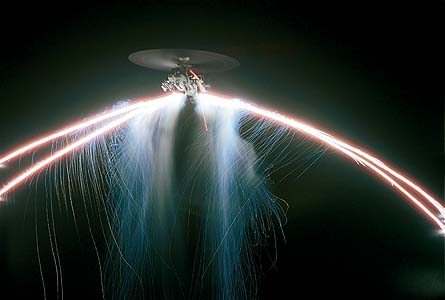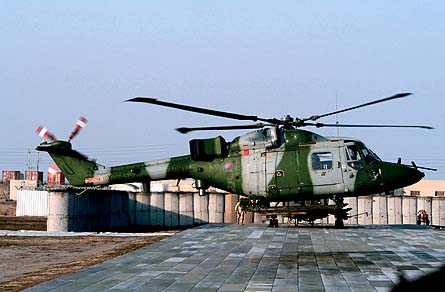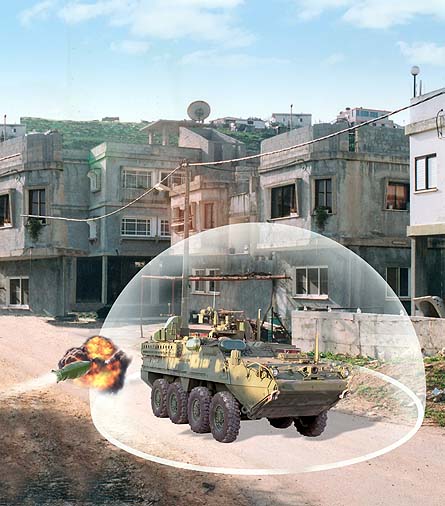By Andrew Healey in London
The British armed forces Lynx AH7 that crashed on to a Basra rooftop in Iraq in May, killing all five on board, was almost certainly downed by a low-tech weapon such as a shoulder-launched missile. It could have been a rocket-propelled grenade (RPG) or even a few lucky shots from a high- calibre machine gun, but a missile is the most likely culprit. There are lots of them in Iraq and there would have been little time to react.
|
|---|
| UK Apaches carry BAE Systems' HIDAS |
Whether it was responsible or not, the heat-seeking man-portable air defence system (Manpads) is an important part of the insurgents’ arsenal. But the missiles they most likely use – the Soviet SA-7 or US Stinger – have been around for several decades. That, and the fact that there may be half a million examples scattered across the globe, has pushed their black market price down to as little as $500. Their relative simplicity also means that launches should be detectable by sensors and deflectable by countermeasures, but as the Lynx is equipped with both, it appears there is no impermeable defence against such attacks.
US defence secretary Donald Rumsfeld acknowledges that confidence in these basic missile defence systems is “not absolute”, with pilots flying evasively to reduce further risk. Whether decoy flares were deployed by the Basra Lynx may never be publicly known: what is known is that the desert heat of Iraq in summer generates plenty of reflective heat sources and an IR system with a limited number of flares would soon run out of them if it reacted to every one. So even an automatic defensive aids suite (DAS) does not render an aircraft invulnerable.
The latest IR-guided missiles – such as the SA-16/18 and later Stinger – are dual-band: they look for secondary heat characteristics generated by a target, not just those of a simple flare. In case any of these have fallen into the insurgents’ hands, a mix of conventional and dual-spectral flares are commonly loaded into helicopter dispensers. Even these are not fool-proof, however: sparks generated by electrified railway lines are a common source of warning sstem distraction.
“Manpads remains the most potent threat facing helicopters today,” says Rod Powell, director of UK countermeasures company Wallop Defence Systems. “The main reason for this is that helicopters routinely fly low and existing countermeasures are passive, so the first crews know about the threat is after it has been launched. With its short range [less than 3.5km/2miles] and high speed, the timing of countermeasures has to be just right.”
Such defensive aids are clearly not infallible. So, can anything be done to improve protection for battlefield helicopters from these threats? Or is vulnerability to missiles, grenades and bullets an unavoidable fact of life for the rotary-wing aviator?
Powell insists that Manpads can normally be dealt with. “Helicopters working in an area that carries the slightest risk of such an attack should have, as a minimum fit, a missile warning receiver (MWR) operating in both the infrared and ultra-violet bands, plus a flare dispenser. A radar warning receiver (RWR) and its associated chaff countermeasure are also highly desirable. The aids can be either retrofitted with their own power source or integrated into the helicopter’s own weapons system.
Threat priority
“An integrated DAS detects, prioritises and counters threats automatically – that is, without any crew intervention. It often incorporates directed infrared countermeasures [DI0RCM], which employs lamps or lasers to distract the missile and has the big advantage of being software re-programmable, enabling it to take evolving threats into account,” says Powell. “However, the integration task is expensive and there is a weight penalty; not least because a helicopter needs extra jam-heads to take care of blind spots that might be presented while manoeuvring.”
|
|---|
| A Lynx HA7 from 847 NAS in Iraq carries a disco light IR jammer, chaff & flare, RWR and LWR |
As well as the basic MTV (magnesium Teflon Viton) and dual-spectral pyrotechnic flares, there are cooler pyrophoric flares made from a chemically coated metallic foil that, instead of burning fiercely close to an aircraft, react on contact with the air. These ‘black’ or ‘dark’ flares radiate in a portion of the IR spectrum that is invisible to the naked eye and, therefore, do not give away an aircraft’s position at night.
But the greatest threat to battlefield rotorcraft is probably the oldest. The RPG has been the bane of conventional armies prosecuting low-intensity guerrilla-type warfare since the end of the Second World War. Tanks may have been this simple weapon’s initial raison d’être, but the slow-moving rotorcraft offers a clear target: even today’s battlefield helicopters are not yet fitted with an effective antidote.
While the US Army has a five-year programme to field a system able to repel such weapons, it is only being developed for ground vehicles. Raytheon has a $70 million contract to develop its Quick Kill anti-projectile defence, one of a range of evolving active-protection systems (APS) that the army hopes will, one day, destroy incoming grenades or missiles by hitting them with projectiles or explosive munitions. Raytheon says the package was put together over mere months and has been proven in test firings against live RPGs on a New Mexico range. The weight penalty makes initial variants unsuitable for helicopters, but the principle, and the demonstrated need, may change, according to army chief of staff Gen Peter Schoomaker.
Solid-state phased-array radar heads, mounted on the vehicle’s four corners, scan for an incoming weapon – say an RPG. When the grenade crosses a 200m (600ft) threshold, a computer calculates its trajectory and swiftly answers several questions, including:
- Will the incoming projectile hit the vehicle?
- If fired, would the defensive projectile threaten friendly troops or vehicles?
- Would the defensive munition violate operational parameters set by the vehicle’s commander, such as not detonating within 10m of the vehicle?
Within 20 milliseconds, if all conditions are correctly met, the computer calculates an intercept course. The munition pops up from one of a quartet of four-round launchers, pitches over as thrusters point it toward the intended intercept point, and a rocket motor ignites to accelerate it toward the incoming weapon. A moment later, a forward-firing warhead detonates, showering the grenade with a 30° cone of fragments and rendering it inert.
Raytheon is developing Quick Kill in two parts. Option A, of greater interest to helicopter commanders, is intended to blunt short-range rocket-propelled grenade attacks, bringing down incoming projectiles at ranges of between 3m and 20m. Option B would be a longer-range system capable of detecting incoming high-explosive tank rounds and top-attack mortar shells up to 2,000m away, and deploying a missile with a semi-active seeker. The first prototype US Army Future Combat Systems (FCS) ground vehicles are slated to be equipped with Quick Kill.
Glynn Raymer, vice-president of Raytheon Combat Systems, says Quick Kill will be able to simultaneously track and engage munitions fired from different directions. The effort is part of the $161 billion FCS programme, which is developing a suite of networked manned and unmanned vehicles. According to FCS programme documents, Quick Kill is set to enter production in 2011 for Stryker and other armoured vehicles.
Army officials apparently chose Quick Kill despite recommendations by the Pentagon’s Office of Force Transformation that it consider the Israeli-developed Trophy active protection system, which is far closer to going into service – the Israeli defence force is due to make a procurement decision for ground vehicles in the coming months.
Rafael’s Trophy appears similar to Quick Kill, and the manufacturer says it is being considered for adaptation to protect helicopters. The threat detection and warning subsystem consists of several sensors, including a search radar with four flat-panel antennas located around the protected vehicle to provide full hemispherical coverage. The neutralisation process will take place only if the threat is assessed as heading for the platform.
Israel Military Industries (IMI) has also developed an APS, dubbed Iron Fist, which is claimed to be capable of defeating a wide range of unguided anti-tank rockets, guided missiles and kinetic energy (KE) rounds. During final tests conducted towards the end of 2005, Iron Fist successfully intercepted a range of anti-tank projectiles, including KE rounds.
Designed to neutralise a threat without initiating the warhead, the system could be adapted for helicopters as the interception creates neither blast nor fragments. “The system’s interceptor is somewhat like a mortar round, carrying insensitive-munitions blast explosive in a combustible envelope,” says Yuval Karakookly, head of IMI’s APS business unit.
Shaped like a small mortar bomb, the Iron Fist interceptor uses only the blast effect to defeat the threat, crushing the soft components of a shaped charge or deflecting and destabilising the missile or kinetic rod in flight. The interceptor is made of a combustible envelope that is consumed in the explosion.
The first two Iron Fist prototypes were installed on an APC and a main battle tank. “In most of the tests, the vehicle sustained no damage at all while, in a few cases, minimal damage was created by the impact of the missile’s tail,” says IMI president Avi Felder. The company is currently developing a lighter version to fit a Humvee.
Last-ditch defence
Armour is the definitive last-ditch form of defence and vital areas of many military helicopters, usually those surrounding humans, are reinforced with ceramic plates. The knack, as always in rotorcraft, is to make it effective without compromising payload or performance. For the past two years the RAF’s Boeing CH-47 Chinook crews have been protected by a modular system developed by the UK’s Permali: a follow-up order is currently in production. It protects cockpit and cabin areas from small-arms fire, at a weight penalty of about 20kg/m2 (4.4lb/ft2).
|
|---|
| Rafael's Trophy effectively creates a force-field around a vehicle |
Some companies have dabbled in the field of reactive armour: a concept first introduced to protect Israeli tanks during the 1973 Yom Kippur war. Explosive reactive armour (ERA) is a common form of add-on protection for armoured fighting vehicles. Protection by low burn-rate explosive modules was successfully used both by Israel and, in the 1980s, by the Russian army. Reactive armour consists of a sloped explosive sheath laid over the steel hull, which is protected by a second plate, and triggered by the impact of a projectile.
Further developments replaced the explosives with an inert layer such as rubber, and electric reactive armour relies on the warhead itself completing a circuit between a charged and uncharged metal layer. When the warhead penetrates the plates, it closes the circuit to discharge the capacitor, thereby sending a great deal of energy into the projectile and (theoretically) vaporising it.
None of these countermeasures could be used in the vicinity of infantry or soft-skin vehicles and their weight – typically 37kg/m2 – would be a serious handicap for aircraft. There would also be a real threat of foreign object damage: Permali’s Nick Baird says he “cannot see (reactive armour) being of practical help aboard any aircraft – let alone a helicopter.”
|
|---|
| Helicopters can carry a mix of MTV and dual-spectral flares |
Several decades ago, UK company MS Instruments developed a hostile fire indicator that detected the supersonic shock wave generated by an approaching round. Unfortunately it could only do that to a range of 20-30m, so it rather assumed the bullet would miss and the pilot would be prepared to do something about the next one. Development continues today, but to improve reliability rather than increase its effective range.
And therein lies the problem. Rick Snyder of US firm Symetrics acknowledges there is still little that can be done against low-tech weapons such as a bullet, RPG or IED (improvised explosive device or roadside bomb). “We’ve tossed around a few ideas that involve setting off different countermeasures – a net maybe, or even dry ice – but nothing that we could pursue practically, and certainly nothing that we could easily transfer to a helicopter,” he says. “And what we do have, reacts to the flash of something being fired at short range so, in a sense, it’s already too late.”
Source: Flight International



























